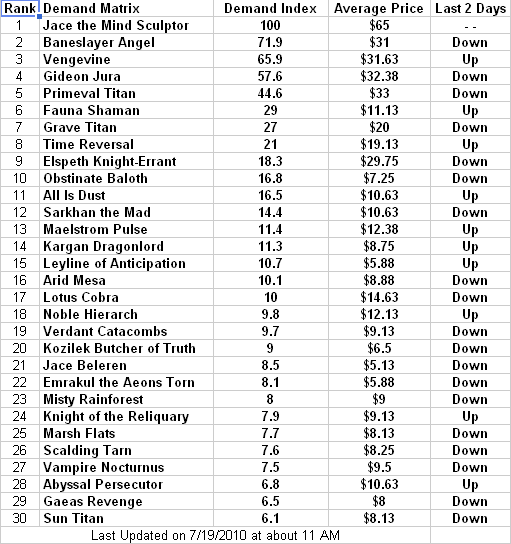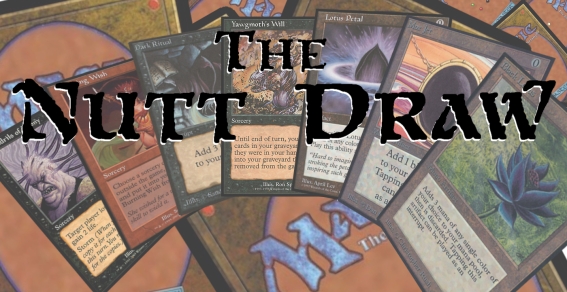Are you a Quiet Speculation member?
If not, now is a perfect time to join up! Our powerful tools, breaking-news analysis, and exclusive Discord channel will make sure you stay up to date and ahead of the curve.
In last week’s article I introduced a concept that could mathematically measure the comparative demand of each Magic: The Gathering single. This week I would like to take some time to explore what that means, and where it comes from. Later on I will explore why it might be useful, how it could be practically implemented, and how it could influence our acquisitions. I believe that the going price of any card (eBay, an online store, or at a local shop) is not enough information to justify the price or value of that card and that by adding an additional, rational figure to the price, we can better understand and perhaps predict singles pricing.
Shortly after the release of M10 last year we were struck with the reality that an in-print, non-limited edition card could demand a $50 price tag, we know her as Baneslayer Angel. The release of Worldwake and some high profile tournaments drove Jace, The Mind Sculptor up to its current price of approximately $80. The MTG communities on Twitter, various forums, and many blogs have been buzzing with talks of overpriced cards, mythics ruining pricing, and pleas for Wizards of the Coast to take action. The price of these cards fairly justify themselves, assuming they are actually being sold -this is basic supply and demand. There are a lot of factors that a retailer has to juggle in order to boldly sell any card at any price. Every piece of inventory they have represents money being tied up in owning them. They didn’t pay as much as they are selling them for of course, but if you were a shop, and you knew that you could buy a Jace, The Mind Sculptor from a local player for $60, and resell it for $80, is that a good business move? It sounds ok, but what if it would take you 60 days to sell it? Would tying up $60 of the stores capital for 2 months be worth it when you could spend the same about on drinks and snacks for the store that you could in turn sell for $120 in 2 weeks? This doesn’t even account for possible changes in the card value to a price below what you bought it for. These are kind of extreme examples, but they are all real. It’s these kinds of decisions that online shops and retail stores make every day, and it’s the ability to make these kinds of decisions correctly that can make any business flourish or bankrupt itself. It’s with this concept that I can justify an $80 price tag on a Jace, The Mind Sculptor from ChannelFireball.com; it is justified because they know what they are doing. They, along with StarCityGames.com, CoolStuffInc.com, and a few others, forge the way into establishing these prices with speculation, knowledge and talent. To me, without a rational means of measuring the demand, I can’t be completely satisfied. I believe these store prices to be accurate, but I won’t rely on faith alone when I think I can work out something more concrete.
Paul, one of my readers, commented on last week’s article about a store grading system which he’s familiar with. They grades cards from A-E and with that grade comes some pricing and margin guidelines. I’m still anxious to learn more about that, run some comparisons and see what I can incorporate into the Demand Matrix. The numbers and formulas that go into creating this list are still in flux, but the concept hasn’t wavered. The structure is to rate every card within a specific subset (Standard, Extended Etc) with a value that compares it’s worth with any other card in the same subset. For example, at the time of writing, a Vengevine is rated at 59.8 compared to a Baneslayer Angel rated at 61.2. Each of those values is based off the card with the highest rating which is currently Jace, The Mind Sculptor rated at 100. The highest card in any subset will always maintain a rating of 100, but any other cards relative values can be derived as a percentage of the higher total. For example, let’s say a Baneslayer Angel is worth exactly 50 and a Fauna Shaman is worth exactly 25 vs Jace, The Mind Scupltor's 100. If you were only comparing the Baneslayer Angel and Fauna Shaman they would be rated 100 and 50 respectively.
Currently these figures are assembled according to the total amount of money spent on each card in a given time frame regardless of the quantity sold. This is where things get more interesting. If we use sales figures over a longer time period we will get a more accurate, but less dynamic indicator because if there was suddenly a run on a $5 rare in one day, it won’t be more than an anomaly over the course of a week. If we use multiple simultaneous values such as a weekly and daily rating then the outcome will be much harder to interpret correctly. If we only look at a single day's value at a time, then we have to ignore the current days data (because it’s incomplete), and will get false positives when by coincidence the state of Utah decides it’s time to complete their fetch land play sets. On top of that, we have to decide what data sets to pay attention to. I personally record sales on certain data sets from completed eBay sales, plus we have access to the MagicTraders.com data which feeds other sites such as the BlackLotusProject.com. I’m inclined to use a combination of both, but am undecided on how to average the data. I should point out that none of these choices are invalid; they are only a different way of looking at the data. I’m working on a way to combine the source data, but I don’t have enough information to do so yet so the current results are all eBay driven. Watch this page though because I have already added in a movement indicator and I’ll soon be adding some formulas that indicate sales spike anomalies. See you next week.

Born in Seattle, Washington, Chris McNutt has been playing and collecting Magic: The Gathering since Unlimited Edition. As an active player, tournament organizer and judge he regularly scrubs out of Pro Tour Qualifiers but inexplicably cleans up at the local draft tables. When not net decking Chris is either busy working as an Information Technology Sales Rep or spending time with his family. Other non-magical pastimes include playing guitar and an unhealthy number of video games. Cursed with an undying love of generating spreadsheets purely for "fun", he'll be crunching the numbers each week in order to serve up delicious data burritos to the salivating, hungry readers of Doubling Season.







I think it's worth noting the scale in the graphs provided as well.